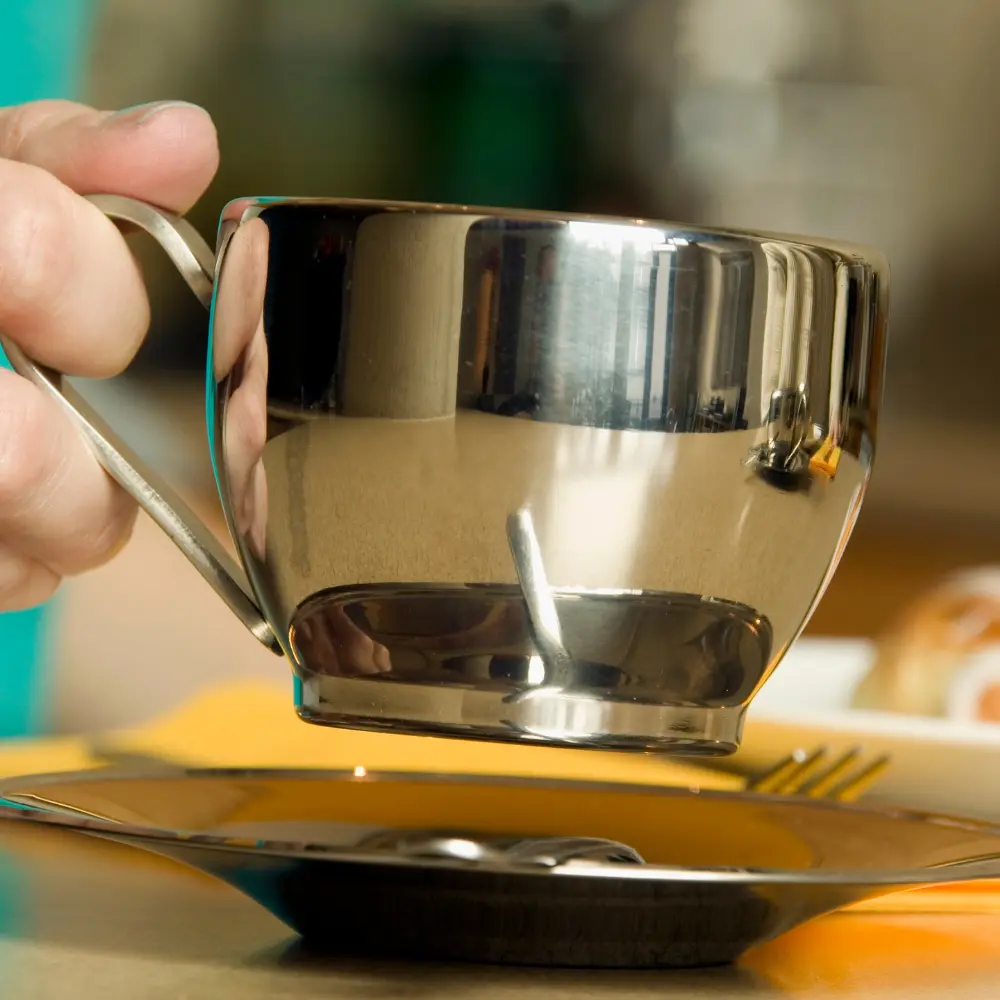For many of us, the day doesn’t really start until we take that first sip of coffee. But have you ever considered how the cup from which you drink your coffee might affect its taste? If you’re a coffee lover who values every nuanced flavor, or even a casual drinker who enjoys a good brew, you might have observed subtle changes in your coffee’s taste depending on the mug you’re using. Some may dismiss this as imagination or mere coincidence, but what if there’s more to it?
In this detailed study, we explore the fascinating world of coffee and the science behind how different mug materials can influence your coffee’s flavor. We’ve sought insights from experts, conducted experiments, and even collected real-world experiences from coffee lovers to create a comprehensive analysis on this topic. Whether you’re a seasoned coffee connoisseur or a curious enthusiast, this exploration will provide you with a fresh perspective on your daily cup of joe. Let’s dive in, shall we?
- The Science Behind Taste Perception: The flavor of coffee is affected by various factors, including the temperature at which it is consumed, its chemistry, and our psychological perception of taste. The material of the mug can influence these elements, altering the taste we perceive.
- Effects of Different Mugs: Ceramic, stainless steel, and glass mugs each interact with coffee differently. Ceramic mugs are excellent at heat retention and offer a neutral taste. Stainless steel mugs are durable and practical, but may alter the coffee’s temperature and flavor. Glass mugs provide a visual appeal, but their heat retention is lower.
- Expert Opinions: Coffee connoisseurs, baristas, and scientists all offer unique insights into how mug material impacts coffee taste. While consensus varies, they affirm that temperature, mug material, and even the mug’s shape can influence the coffee experience.
- Real-world Experiences: Personal experiences with different coffee and mug combinations underscore the subjective nature of coffee drinking. Many coffee lovers enjoy experimenting with different mugs to enhance their coffee experience, and their experiences often align with scientific explanations and expert opinions.
- Choosing the Right Mug: Selecting the right coffee mug involves considering the material, size, shape, and design. Proper mug maintenance is also essential to ensure the best coffee experience. Ultimately, the ideal coffee mug aligns with your personal preferences and enhances your coffee rituals.
The Science Behind Coffee Flavor Perception
Coffee is more than just a morning staple or an energy booster. It’s a complex brew that hinges on science, especially when it comes to flavor perception. Understanding this will help us see why different mugs can create distinct taste experiences.
Understanding the Chemistry of Coffee
First and foremost, coffee is a cocktail of over 800 compounds that contribute to its aroma and flavor. When coffee beans are roasted, chemical reactions unfold that produce these compounds, giving us the intricate flavors we relish, ranging from sweet and fruity to bitter and smoky. Each coffee variety has a unique profile, determined by factors such as the bean’s origin, roast level, and brewing method. (1)

However, flavor isn’t just a matter of chemistry. The material of your coffee mug can interact with these compounds. For instance, some materials may absorb certain flavor compounds, while others may alter the coffee’s temperature, affecting volatile compounds responsible for the aroma and, consequently, taste perception.
Heat Retention and Its Impact on Coffee Taste
Temperature plays a vital role in how we perceive coffee’s flavor. As the coffee cools, its chemistry changes. Certain aromatic compounds, which significantly contribute to coffee’s flavor, are more volatile at higher temperatures. This means they evaporate and reach our noses more readily when the coffee is hot, enhancing its flavor. A mug that doesn’t retain heat well will allow the coffee to cool quickly, potentially diminishing these flavors.

Different mug materials have different thermal conductivities. For example, ceramic has low thermal conductivity, helping to keep the coffee hot for longer. On the other hand, metal mugs can absorb heat quickly, causing the coffee to cool down faster. (2) Understanding the heat retention properties of your mug material can help you control your coffee’s temperature and, in turn, its taste.
The Psychology of Taste Perception in Coffee
Our perception of coffee’s taste isn’t merely about the tongue—it’s a multisensory experience involving sight, touch, smell, and even sound. The color, shape, and weight of your mug can impact how you perceive the taste of your coffee.

For example, research has shown that people often associate the color white with bitterness, meaning that coffee drunk from a white mug might taste more bitter than when drunk from a mug of a different color. Similarly, the weight of the mug can affect perceived sweetness—with a heavier mug often enhancing sweetness.
Ultimately, the taste of coffee is a complex interplay of chemistry, physics, and psychology. It’s a brew that engages multiple senses, and each element, including your coffee mug, can shape that delightful coffee experience.
Different Types of Coffee Mugs and Their Effects
It’s not uncommon for coffee enthusiasts to own an assortment of coffee mugs made from different materials. Each material brings something unique to the table, affecting heat retention, flavor profile, and overall coffee experience. Let’s explore some of the most common ones.
The Impact of Ceramic Mugs on Coffee Taste
Ceramic mugs are perhaps the most traditional and widely used for drinking coffee. Ceramic is a poor conductor of heat, meaning it can maintain your coffee’s temperature for a longer time, keeping those volatile aromatic compounds intact. Its dense and mostly non-porous nature ensures it doesn’t absorb flavors or odors, offering a ‘clean’ taste with every brew. (3)

Another interesting aspect of ceramic mugs is their weight. As per the psychology of taste perception, a heavier mug can enhance the perceived sweetness of your coffee, making ceramic an excellent choice for those who like a touch of sweetness in their coffee.
Stainless Steel Mugs and Coffee: A Complex Relationship
Stainless steel mugs are a popular choice for people on the go due to their durability and heat-retention properties. However, the relationship between coffee and stainless steel is a little complex when it comes to taste.

Stainless steel conducts heat faster than ceramic, which means your coffee might cool down more quickly, potentially altering the flavor profile. Furthermore, some people report a metallic taste when drinking from stainless steel mugs. It’s debatable whether this is due to the actual interaction between coffee and steel or merely a psychological effect.
The Glass Mug Debate: Does it Really Affect Your Brew?
Glass mugs, with their elegant appearance, allow you to visually enjoy your coffee’s rich color and texture. However, the impact of glass on coffee taste is a subject of ongoing debate among coffee enthusiasts.

Like ceramic, glass doesn’t absorb flavors or odors, ensuring a ‘pure’ coffee taste. However, it doesn’t retain heat as well as ceramic or stainless steel, which might affect the temperature and, consequently, the flavor profile of your coffee. (4)
On the other hand, the transparency of glass mugs offers a visual component to the coffee-drinking experience. Seeing the rich, dark brew can enhance the anticipation and perception of taste even before you take your first sip.
To sum up, each type of coffee mug, with its unique characteristics, can influence your coffee experience in different ways. Choosing the right mug involves considering the taste, temperature, and even the aesthetic you prefer for your daily brew.
Dodging the Detrimental: Coffee Mug Materials to Evade
Despite the wide array of materials available for coffee mugs, not all are created equal when it comes to safeguarding the sanctity of your coffee’s flavor. There are a few culprits on the market that could potentially spoil your coffee experience.
- Plastic Mugs: While lightweight and durable, plastic mugs are not the best friends of coffee. They are prone to retaining odors and stains from past brews, which can distort the taste of your fresh cup. Moreover, hot coffee can cause certain plastics to leach chemicals, raising health concerns.
- Cheap Metals: Certain metals, such as aluminum or poorly-coated stainless steel, can give your coffee a distinct metallic taste. In addition, they may react with the acidity in the coffee, leading to off-flavors.
- Unsealed Wood or Bamboo: Wooden or bamboo mugs can offer a unique, rustic appeal, but they aren’t ideal for coffee if they aren’t properly sealed. They can absorb coffee oils and odors over time, impacting the taste of your brews.
In your quest for the perfect coffee experience, steering clear of these materials can help ensure that nothing comes between you and the pure, delightful flavor of your coffee.
Expert Opinions on Mug Material and Coffee Taste
Our exploration wouldn’t be complete without perspectives from those who live and breathe coffee – coffee connoisseurs, professional baristas, and scientists specializing in food and drink. Each offers unique insights into the role of mug material in coffee taste.
Coffee Connoisseur’s Take on Mug Selection
Coffee connoisseurs, with their refined palates, often have insightful opinions about the influence of mug material on coffee taste. Most advocate for ceramic or porcelain mugs as they argue these materials offer the most ‘true’ coffee flavor due to their neutral properties. As discussed earlier, ceramic and porcelain are poor heat conductors, keeping the coffee hot and allowing the full spectrum of flavors to bloom.

However, connoisseurs also stress that personal preference plays a crucial role in mug selection. Some might prefer the slight cooling in a metal mug for their iced coffee or enjoy the aesthetic appeal of a glass mug that allows them to appreciate the color and texture of their brew.
Barista Insights: The Role of Mug Material in Serving Coffee
In cafes around the world, baristas often serve coffee in ceramic or porcelain cups. Besides aesthetic reasons, this choice is also driven by practical considerations. Ceramic mugs retain heat well, keeping the coffee at an optimal temperature while customers chat or enjoy their pastry.
Interestingly, some baristas suggest that the shape of the mug can influence how we experience coffee. A wider rim, for instance, allows more aromas to reach our noses, enhancing the coffee’s flavor profile.
Scientist Perspective: The Physics and Chemistry of Coffee Mugs
From a scientific standpoint, the influence of mug material on coffee taste is a fascinating subject combining physics and chemistry. Scientists affirm that temperature plays a significant role in how we perceive flavor. Therefore, the heat conductivity of the mug material can affect the coffee’s taste by altering its temperature.
Furthermore, researchers have started to explore how the psychological and sensory elements of mug selection, such as color, shape, and weight, can influence taste perception. These studies often support the anecdotal evidence we’ve seen from coffee lovers and experts, affirming that the coffee experience is a blend of various sensory inputs.
Collectively, these expert perspectives shed light on how different mugs can shape our coffee experience. They remind us that enjoying coffee is both a science and an art, blending physical properties with personal preferences. (5)
Real World Experiences with Coffee and Mug Combinations
Beyond scientific research and expert opinions, real-world experiences offer valuable insights into how coffee and mugs interact. These experiences, anecdotes, and experiments from coffee lovers worldwide help paint a holistic picture of this intriguing topic.
Personal Stories: Coffee Lovers’ Experiences with Different Mugs
There are numerous accounts from coffee enthusiasts who’ve noticed differences in their coffee taste depending on the mug they used. Some report their coffee tastes better from their favorite ceramic mug than a travel-friendly stainless steel one. Others have shared that they enjoy their coffee more from a glass mug, suggesting that the visual appeal enhances the overall experience.

On the other hand, many coffee drinkers remain indifferent, maintaining that they don’t notice any significant differences between mugs. These varying anecdotes underline the subjective nature of coffee drinking and how individual preferences and perceptions can influence the experience.
Experimental Approaches to Coffee Brewing and Drinking
Many coffee lovers have taken their curiosity further by conducting their home experiments, comparing the taste of the same coffee from different mugs. These DIY experiments often involve tasting the same coffee from ceramic, glass, and stainless steel mugs in quick succession.

While these experiments lack the rigorous controls of a scientific study, they still offer valuable, firsthand insights into the impact of mug materials on coffee taste. Findings vary, but the common thread seems to be that there’s no one-size-fits-all answer. The ‘best’ mug for coffee depends on many factors, including individual taste preferences and how quickly one drinks their coffee.
Tips for Enhancing Your Coffee Experience

Drawing from these experiences, here are some practical tips to enhance your coffee experience:
- Find the right mug for you: If you’re serious about your coffee, don’t be afraid to experiment with different mugs and observe any changes in your coffee’s taste.
- Consider the coffee type: Some coffees might be more sensitive to temperature changes, which could be affected by the mug’s material.
- Don’t overlook aesthetics: The visual appeal of your coffee mug can enhance your overall experience. Find a mug that you love to look at and hold.
- Keep your mugs clean: Regardless of the material, regular cleaning of your mugs is essential to avoid the buildup of residues that could alter your coffee’s taste.
At the end of the day, the best coffee experience is a personal journey. Exploring different coffee and mug combinations can be a fun and exciting way to enhance your daily brew.
How to Choose the Right Mug for Your Coffee
With a better understanding of how different mugs can influence your coffee taste, you might be wondering how to choose the right mug for your coffee. In this section, we’ll provide you with some practical guidance.
Factors to Consider When Buying Coffee Mugs

When selecting a coffee mug, you’ll want to consider several factors:
- Material: As we’ve discussed, the material can impact your coffee’s temperature and potentially its flavor. Consider whether you prefer ceramic, stainless steel, glass, or another material.
- Size: The size of your mug should align with how much coffee you typically drink. Also, consider if you prefer larger, more spacious mugs or compact ones that keep your coffee warmer for longer.
- Shape: The shape of the mug, particularly the width of the rim, can affect how you perceive your coffee’s aroma and taste. A wider rim allows more aromas to reach your nose.
- Color and Design: The look and feel of the mug can also enhance your coffee-drinking experience. Choose a design that you love and that makes you happy.
The Ideal Coffee Mug: Opinions from the Coffee Community
Within the coffee community, there’s no consensus on the ‘ideal’ coffee mug as it largely comes down to personal preference. However, many coffee lovers lean towards ceramic or porcelain mugs for their heat retention properties and their ‘neutral’ influence on the coffee’s taste.

The aesthetic appeal of the mug also holds importance in the community. As mentioned before, some prefer the elegance of glass mugs that allow them to visually appreciate their brew, while others might be drawn to the durability and practicality of stainless steel mugs.
Coffee Mug Maintenance: Preserving Taste and Quality
Regardless of the type of mug you choose, proper maintenance is crucial to ensure that it doesn’t negatively affect your coffee taste. Over time, coffee residues can build up and impart unwanted flavors. Regular cleaning, preferably after each use, is essential. Avoid using strong detergents that might leave a residue and affect the taste.

For materials like ceramic and porcelain, check for cracks regularly. Cracks can harbor residues and bacteria, potentially affecting your coffee’s flavor.
With stainless steel mugs, be sure to rinse thoroughly and dry them properly to prevent any metallic taste in your future brews.
In the end, the best mug for you is the one that enhances your coffee experience, aligns with your lifestyle and preferences, and brings joy to your coffee rituals. Explore, experiment, and enjoy the journey!
Conclusion
In conclusion, the notion that coffee tastes different in various mugs is not just a perception—it’s a fascinating reality backed by science, expert opinions, and real-world experiences. This journey into the interplay between coffee and mug materials highlights the complexity of coffee drinking, extending beyond just the beans and brewing methods to include even the vessel we drink from.
From the chemistry of coffee to the material properties of mugs, to the psychological and sensory factors of taste perception, we’ve seen how each aspect can shape our coffee experience. Ceramic, stainless steel, and glass mugs each offers unique advantages and influences on your coffee’s taste, temperature, and overall enjoyment.
However, despite all these complexities, the ‘best’ mug for your coffee ultimately boils down to your personal preferences. Whether you’re a casual coffee drinker or a dedicated coffee connoisseur, we encourage you to experiment with different mugs and explore how they impact your coffee experience. After all, enjoying coffee is as much a personal journey as it is a sensory delight.
Keep exploring, keep experimenting, and above all, keep enjoying your coffee, one mug at a time.
FAQ
What material is best for a coffee mug to maintain flavor?
Many experts recommend ceramic or porcelain mugs as they retain heat well and don't impart additional flavors to the coffee.
How do baristas choose the right mugs for serving coffee?
Baristas often choose ceramic or porcelain mugs because of their heat retention properties and neutral effect on coffee flavor. The mug's shape, which can affect aroma perception, is also considered.
Is there any scientific research supporting the impact of mug shape on coffee taste?
Yes, scientific research has shown that the shape of a mug can influence coffee taste through factors like psychological perceptions.
How can I enhance my coffee experience through mug selection?
You can enhance your coffee experience by experimenting with mugs of different materials, sizes, and shapes, and noting how these variations affect your perception of your coffee's taste.




























